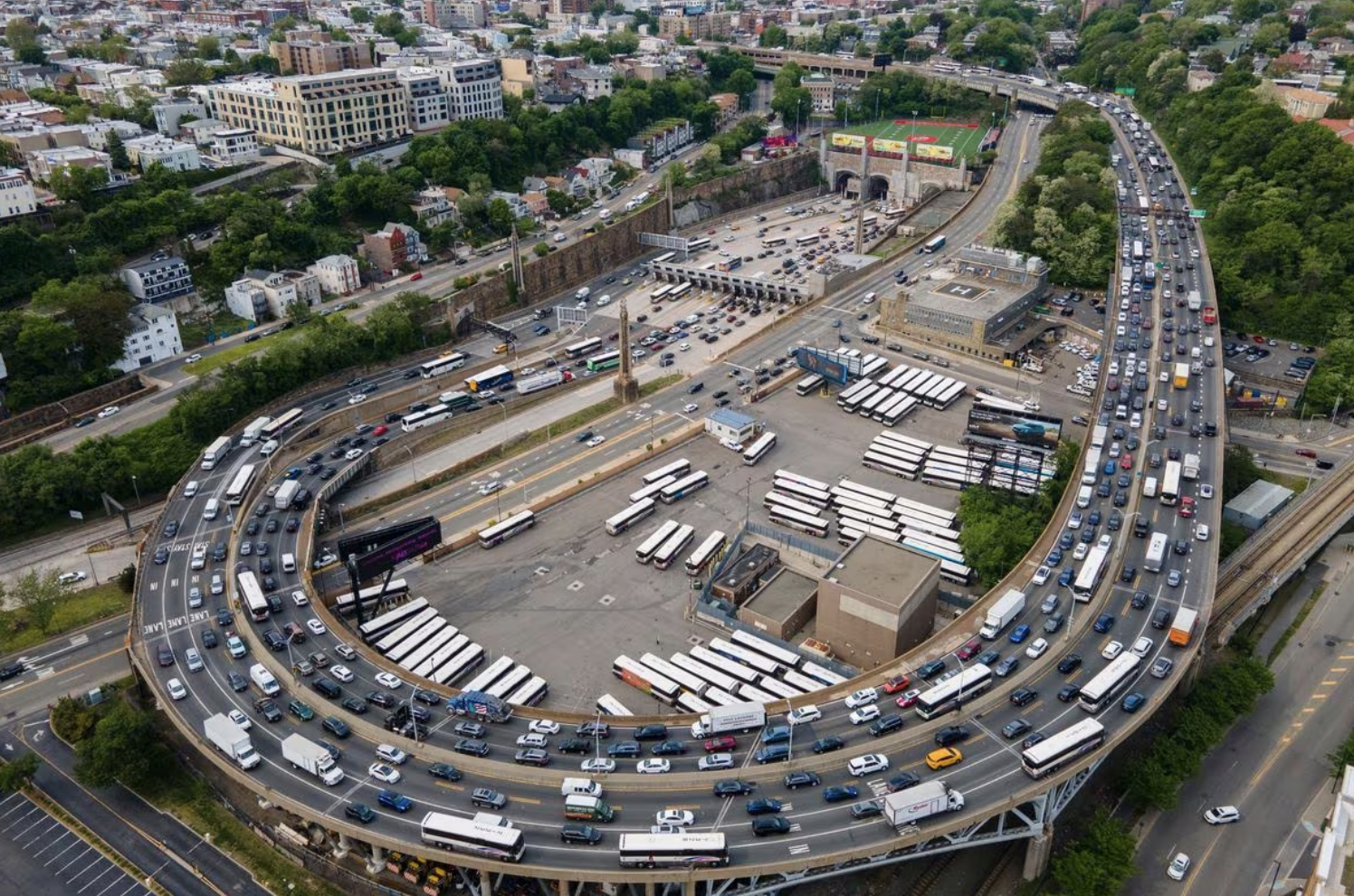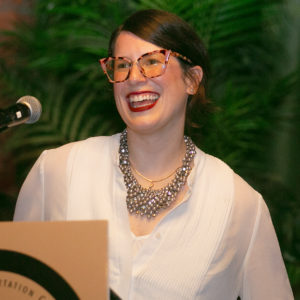Testimony of Jaqi Cohen, Director of Climate and Equity Policy at Tri-State Transportation Campaign
January 24, 2024
Thank you for the opportunity to testify before you today and comment on the FY2025 budget. My name is Jaqi Cohen and I am the Director of Climate and Equity Policy for Tri-State Transportation Campaign, an advocacy organization dedicated to advocating for sustainable, equitable, and safer mobility in New York, New Jersey, and Connecticut since 1993.
Decarbonizing New York’s Transportation Sector
Transportation remains a significant contributor to New York State’s emissions, responsible for over a third of the total. Aligning with the state’s ambitious climate goals as mandated by the Climate Leadership and Community Protection Act (CLCPA), transforming our state’s transportation sector is pivotal in achieving a more sustainable, fossil-free New York. The reduction of reliance on fossil fuels, facilitated by the enhancement of public transit and the shift towards vehicle electrification, is crucial. These steps are not only imperative to meet the stringent emissions reduction targets set by the CLCPA but are also practical and achievable strategies in our transition to a sustainable transportation future.
One vital tool New York must support is the transition away from internal combustion engine vehicles to zero-emission vehicles, particularly for medium- and- heavy-duty vehicles and transit fleets. To this end, TSTC urges your support for Green Transit, Green Jobs (S.6089/A.6414). Green Transit, Green Jobs will achieve a zero-emissions transit bus fleet by phasing out purchases of new fossil fuel transit buses starting in 2029.
The surge in statewide transportation emissions has been further exacerbated by the proliferation of e-commerce and same-day delivery. This booming industry has completely changed the landscape of how New Yorkers buy and receive goods. As a result, one in four New Yorkers find themselves living within half a mile of a mega-warehouse, according to an illuminating new study authored by our colleagues at the Environmental Defense Fund.
These mega-warehouses, integral to the e-commerce surge, are more than just storage spaces; they are epicenters of relentless truck traffic and escalating air pollution. The consequences are severe, disproportionately affecting underserved communities and communities of color. Children, the elderly, and low-income families in these areas are the most vulnerable, facing increased health risks like asthma due to poor air quality.
To mitigate some of this damage, TSTC urges your support for the Clean Deliveries Act (S.2127a/A.1718a). The Clean Deliveries Act seeks to establish crucial regulations for warehouse operations, demanding a shift to zero-emission vehicles and cleaner, more efficient transportation methods. This legislation doesn’t simply address mobile pollution; it will begin to correct a systemic injustice where economic development has come at the expense of our most vulnerable communities’ health and well-being.
Making Streets Safer for All New Yorkers
Improving road safety across New York State is a multifaceted challenge that requires comprehensive strategies. Firstly, implementing Vision Zero principles at the state level by DOT is crucial. New York City’s experience with Vision Zero has shown significant improvements in reducing injuries and fatalities on its most dangerous corridors. However, many of the deadliest roads in New York are state-controlled. To extend these safety improvements statewide, it is essential to consider initiatives like increasing registration fees for larger, more dangerous vehicles and equipping state vehicles with safety features such as truck side guards and intelligent speed control devices, as has been piloted successfully in New York City.
There is a pressing need to increase funding for Complete Streets projects from $5 million to at least $10 million. Complete Streets designs prioritize the safety and accessibility of all road users, including pedestrians, cyclists, and drivers. Integrating Complete Streets principles with routine road maintenance, such as resurfacing, offers an opportune moment to redesign streets for enhanced safety. However, a mandatory Complete Streets analysis prior to such maintenance projects is not currently a requirement, which represents a missed opportunity for improving road safety.
Lastly, we echo our colleagues at Families for Safe Streets and demand that Sammy’s Law (S.2422a/A.7266) be included in this year’s budget. This law would empower New York City to set more appropriate, safer speed limits, a change that could significantly reduce the costs associated with traffic crashes, including emergency services and lost economic activity. By allowing for lower speed limits, Sammy’s Law would directly contribute to reducing the incidence and severity of traffic accidents.
Collectively, these measures represent a comprehensive approach to making streets safer across New York State. Implementing Vision Zero at the state level, increasing funding for Complete Streets, and enacting Sammy’s Law are three critical steps New York must take towards reducing traffic-related injuries and fatalities, and ensuring that New York’s roads are safe for all users.
Investing in Transportation Equity
Investment in transportation should prioritize equity, shifting focus from highway expansion projects which have historically harmed disadvantaged communities, to enhancing public transit, safer streets, and increased mobility for all New Yorkers, whether or not they own a car.
Investing in transportation equity is essential for creating a more inclusive and sustainable future in New York State. A key aspect of this investment is the development of trails and greenways, which offer safe, accessible, and environmentally friendly transportation options. Specifically, funding should be allocated to complete the Motor Parkway Greenway, a project that will connect Eastern Queens to Nassau County. Additionally, extending the Empire State Trail to Long Island will further enhance the network of trails, providing more opportunities for non-motorized travel and recreation, thus promoting healthier, more sustainable communities.
Crucial to providing transportation equity is the adoption of a statewide ‘Fix it First’ approach in highway infrastructure projects. This strategy prioritizes the repair and maintenance of existing roadways over the expansion of new ones. Highway projects should explicitly exclude any widening efforts, as these tend to encourage induced roadway demand and subsequently, higher vehicle miles traveled (VMT). Currently, the Governor’s proposed budget funds several highway expansion projects, like Route 17 in Sullivan and Orange Counties and the Kensington Expressway in Buffalo. Instead, the state should embrace a VMT reduction strategy, focusing on reducing dependency on automobile travel. This approach not only aligns with environmental sustainability goals but also addresses issues of urban sprawl and the equitable distribution of transportation resources. TSTC strongly supports Senator Gounardes and Assemblymember McMahon’s VMT reduction bill (S.1981/A.4120) which would mandate a statewide VMT reduction target of 15% by 2050.
Ensuring the Success of NYC’s Congestion Pricing Program
The key to ensuring safer, more reliable, efficient, and accessible public transit, as well as cleaner air, less traffic congestion, and safer roads in New York City, is through a swift implementation of congestion pricing. Congestion pricing is expected to generate $1 billion per year, thus allowing the MTA to complete its essential capital program to remedy longstanding issues plaguing our public transit systems.
TSTC strongly opposes any new exemptions to the congestion tolling program. New exemptions to the program threaten to greatly undermine its success and threaten the core goals of the program: reducing traffic congestion, curbing pollution, and generating vital revenue to fund public transit.
Greater NYSDOT Accountability
The New York State Department of Transportation (NYSDOT) oversees a substantial capital plan of $32.9 billion, a critical investment in our state’s transportation infrastructure. However, the 2022-2027 capital plan project list has not yet been released as open data on data.ny.gov, despite the directives of Executive Order 95 of 2013. This availability of detailed project information is vital for fostering public understanding and participation.
NYSDOT’s 2021 Transparency Plan demonstrates its commitment to openness. Releasing the capital plan project list as open data would align with this commitment and Executive Order 95, enhancing public trust and accountability. Such transparency is key in ensuring that the management and allocation of these significant funds are conducted inclusively and responsibly. TSTC requests that NYSDOT be required to provide its $32.9 billion capital program in Open Data format, as laid out in Executive Order 95 of 2013.
Thank you for the opportunity to testify today.
For more information, please contact:
Jaqi Cohen
jaqi@tstc.org

